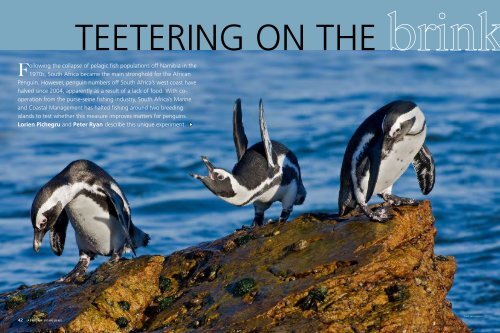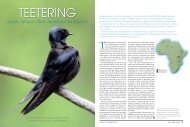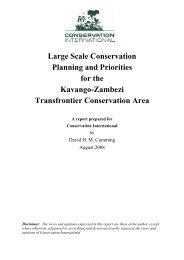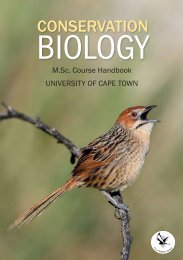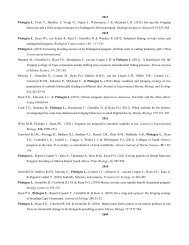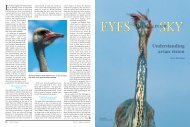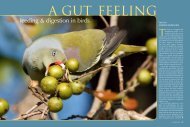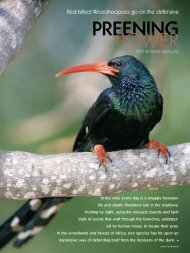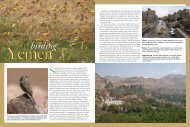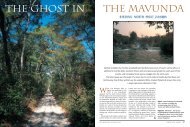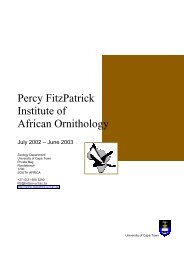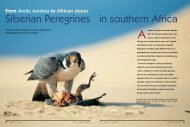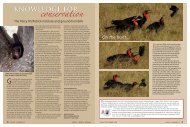Teetering on the brink - Percy FitzPatrick Institute of African ...
Teetering on the brink - Percy FitzPatrick Institute of African ...
Teetering on the brink - Percy FitzPatrick Institute of African ...
You also want an ePaper? Increase the reach of your titles
YUMPU automatically turns print PDFs into web optimized ePapers that Google loves.
teetering <strong>on</strong> <strong>the</strong>Following <strong>the</strong> collapse <strong>of</strong> pelagic fish populati<strong>on</strong>s <strong>of</strong>f Namibia in <strong>the</strong>1970s, South Africa became <strong>the</strong> main str<strong>on</strong>ghold for <strong>the</strong> <strong>African</strong>Penguin. However, penguin numbers <strong>of</strong>f South Africa’s west coast havehalved since 2004, apparently as a result <strong>of</strong> a lack <strong>of</strong> food. With cooperati<strong>on</strong>from <strong>the</strong> purse-seine fishing industry, South Africa’s Marineteetering <strong>on</strong> <strong>the</strong>and Coastal Management has halted fishing around two breedingislands to test whe<strong>the</strong>r this measure improves matters for penguins.Lorien Pichegru and Peter Ryan describe this unique experiment.42 african penguinschris van rooyen
seine languageThe <strong>African</strong> Penguin Spheniscus demersus is<strong>on</strong>e <strong>of</strong> seven seabird species c<strong>on</strong>fined to <strong>the</strong>Benguela upwelling regi<strong>on</strong> <strong>of</strong>f <strong>the</strong> coast <strong>of</strong>sou<strong>the</strong>rn Africa. Like penguins worldwide, this specieshas broad public appeal, and its accessible breedingcol<strong>on</strong>ies at Boulders Beach and St<strong>on</strong>y Point c<strong>on</strong>tributesignificantly to <strong>the</strong> tourism value <strong>of</strong> <strong>the</strong> WesternCape. But all is not well in penguin land. At <strong>the</strong> start<strong>of</strong> <strong>the</strong> 19th century <strong>the</strong>re were about a milli<strong>on</strong> <strong>African</strong>Penguins <strong>on</strong> Dassen Island al<strong>on</strong>e; currently <strong>the</strong>re arefewer than 30 000 pairs worldwide.Coupled with <strong>the</strong> disturbance caused by peoplescraping for guano, <strong>the</strong> <strong>African</strong> Penguin’s initialdecrease resulted from egg collecting, with as manyas 600 000 eggs being taken from Dassen IslandAbovePorpoising is a fast but energetically expensive way for <strong>African</strong>Penguins to travel at sea. Most commuting is d<strong>on</strong>e at a more sedatethree to six kilometres an hour, which saves energy but c<strong>on</strong>strains<strong>the</strong> area <strong>the</strong>y can search for food when breeding.opposite<strong>African</strong> Penguins can suffer from heat stress ashore, especially whenbreeding in exposed sites. Excepti<strong>on</strong>ally hot days can cause parents todesert <strong>the</strong>ir nests, leaving <strong>the</strong>ir eggs and chicks exposed to predati<strong>on</strong>.albert fr<strong>on</strong>eman (2)each year. But penguin numbers have c<strong>on</strong>tinued todecrease after <strong>the</strong>se activities ceased. Loss <strong>of</strong> guan<strong>of</strong>rom <strong>the</strong> breeding islands has made it more difficultfor <strong>the</strong> birds to find suitable nests, thus reducingbreeding success, and oil polluti<strong>on</strong> is an <strong>on</strong>goingproblem. But <strong>the</strong> main reas<strong>on</strong> for <strong>the</strong> species’ decreasesin recent decades has been a shortage <strong>of</strong> food. Likemany o<strong>the</strong>r predators in <strong>the</strong> Benguela regi<strong>on</strong>, adult<strong>African</strong> Penguins rely <strong>on</strong> sardines and anchovies for<strong>the</strong> bulk <strong>of</strong> <strong>the</strong>ir diet. As <strong>the</strong>se pelagic schooling fishalso form <strong>the</strong> basis <strong>of</strong> a valuable purse-seine fishery,penguins compete with humans for food.Off Namibia, <strong>the</strong>re was a dramatic collapse insardine landings during <strong>the</strong> early 1970s. Pelagic fishwere replaced by jellyfish and salps, which c<strong>on</strong>sumedmost <strong>of</strong> <strong>the</strong> eggs and larvae produced by <strong>the</strong> dwindlingfish populati<strong>on</strong>s. This has switched <strong>the</strong> systemto a new stable state dominated by <strong>the</strong>se gelatinouszooplankt<strong>on</strong>. The bad news for penguins is that jellyfishand salps are a poor substitute for pelagic fishand cannot sustain significant seabird populati<strong>on</strong>s.As a result, populati<strong>on</strong>s <strong>of</strong> seabirds breeding at <strong>the</strong>Namibian guano islands have decreased dramatically.Over <strong>the</strong> past five decades, <strong>African</strong> Penguin numbersin Namibia have decreased by more than 90 per cent,from some 50 000 pairs in <strong>the</strong> 1950s to <strong>on</strong>ly 5 000pairs in <strong>the</strong> 2000s.The sou<strong>the</strong>rn Benguela <strong>of</strong>f South Africa also saw acrash in sardine landings following over-exploitati<strong>on</strong> in<strong>the</strong> 1960s, but much <strong>of</strong> <strong>the</strong> slack in <strong>the</strong> system wastaken up by anchovies. Careful management <strong>of</strong> <strong>the</strong> fisheryduring <strong>the</strong> 1970s and 1980s saw <strong>the</strong> slow recovery<strong>of</strong> sardines, and by <strong>the</strong> 1990s seabird populati<strong>on</strong>s wereincreasing, linked to a few bumper years <strong>of</strong> anchovyrecruitment. Unfortunately, <strong>the</strong> good times haven’tlasted. During <strong>the</strong> past decade, pelagic fish stocks havedwindled <strong>of</strong>f <strong>the</strong> west coast, where most penguinstraditi<strong>on</strong>ally have bred, forcing predators – and <strong>the</strong>fishery – to travel far<strong>the</strong>r and far<strong>the</strong>r south and east inpursuit <strong>of</strong> prey. The south-eastward movement <strong>of</strong> preyis thought to result from a combinati<strong>on</strong> <strong>of</strong> envir<strong>on</strong>mentalfactors favouring populati<strong>on</strong>s breeding <strong>on</strong> <strong>the</strong> southcoast ra<strong>the</strong>r than <strong>the</strong> west coast, coupled with greaterfishing pressure al<strong>on</strong>g <strong>the</strong> west coast, where fleets andprocessing plants are c<strong>on</strong>centrated.A shift in penguin prey isn’t too serious when <strong>the</strong>birds are free to follow it. But, while breeding,adult penguins depend <strong>on</strong> a reliable source <strong>of</strong> foodfor <strong>the</strong>mselves and <strong>the</strong>ir chicks close to <strong>the</strong> breedingisland, and most <strong>African</strong> Penguins remain within 20 to30 kilo metres <strong>of</strong> <strong>the</strong>ir breeding islands at this time. Birdsforced to travel fur<strong>the</strong>r than this spend so l<strong>on</strong>g commutingthat <strong>the</strong>y struggle to raise a brood <strong>of</strong> healthychicks. To make matters worse, adult <strong>African</strong> Penguinsare creatures <strong>of</strong> habit and return to breed at <strong>the</strong> samesite each year. As a result <strong>of</strong> <strong>the</strong> lack <strong>of</strong> food, penguinnumbers <strong>of</strong>f South Africa’s west coast fell from almost40 000 pairs in 2004 to barely 12 000 pairs in 2008.This calamitous decrease has led for calls to upgrade<strong>the</strong> species from globally Vulnerable to Endangered.The fishing industry faces a similar challenge from<strong>the</strong> shift in fish stocks. L<strong>on</strong>ger commuting distancesbetween fishing areas and processing plants, coupledwith sharp increases in fuel prices, have forced somecompanies to make <strong>the</strong> costly decisi<strong>on</strong> to relocate <strong>the</strong>irplants to Mossel Bay <strong>on</strong> <strong>the</strong> south coast. Sadly, thisopti<strong>on</strong> isn’t open to penguins, as <strong>the</strong>re are no suitablebreeding islands between Dyer Island, just east <strong>of</strong>Hermanus, and Port Elizabeth. A few pairs have triedto breed al<strong>on</strong>g <strong>the</strong> remote De Hoop coastline, but <strong>the</strong>yare vulnerable to terrestrial predators.Although climate change might be <strong>the</strong> ultimatefactor driving <strong>the</strong> shift in fish populati<strong>on</strong>s,competiti<strong>on</strong> with purse-seine fisheries aroundbreeding col<strong>on</strong>ies almost certainly exacerbates <strong>the</strong> situati<strong>on</strong>for penguins. As a result, Marine and CoastalManagement, <strong>the</strong> government agency resp<strong>on</strong>sible formanaging South Africa’s fisheries and marine resources,has devised an ambitious plan to try to improve c<strong>on</strong>diti<strong>on</strong>sfor breeding penguins. With <strong>the</strong> cooperati<strong>on</strong> <strong>of</strong><strong>the</strong> purse-seine industry, fishing has been stopped foran initial two-year period within 20 kilometres <strong>of</strong> twokey breeding sites: Dassen Island <strong>on</strong> <strong>the</strong> west coast andSt Croix Island <strong>of</strong>f Port Elizabeth. Teams <strong>of</strong> scientistswill m<strong>on</strong>itor whe<strong>the</strong>r this improves <strong>the</strong> lot <strong>of</strong> penguinsbreeding <strong>the</strong>re compared with birds breeding <strong>on</strong> nearbyislands that have not been afforded any protecti<strong>on</strong>,namely Robben and Bird islands.Lorien Pichegru, a post-doctoral fellow at UCT’s<strong>FitzPatrick</strong> <strong>Institute</strong>, has been tasked with m<strong>on</strong>itoring<strong>the</strong> performance <strong>of</strong> penguins breeding at St Croixand Bird islands in Nels<strong>on</strong> Mandela Bay. Typically,fishing pressure is far greater around St Croix, whichlies close to Port Elizabeth. Perhaps as a result <strong>of</strong> this,<strong>African</strong> Penguins breeding <strong>on</strong> St Croix in 2008 hadto work much harder than those breeding <strong>on</strong> BirdIsland to find food for <strong>the</strong>ir chicks, travelling <strong>on</strong> averagealmost twice as far. From <strong>the</strong> start <strong>of</strong> 2009, fishinghas ceased within 20 kilometres <strong>of</strong> St Croix andwithin a five-kilometre radius <strong>of</strong> <strong>the</strong> Riy Bank, a keyarea for fish south <strong>of</strong> St Croix.Pichegru and a team <strong>of</strong> students will test what effectthis has <strong>on</strong> <strong>the</strong> islands’ penguins over <strong>the</strong> next twoyears. She will use GPS-loggers to track foraging birdsand thus estimate <strong>the</strong>ir foraging effort, and couple<strong>the</strong>se data with more traditi<strong>on</strong>al measures suchas populati<strong>on</strong> size, diet sampling, breedingsuccess and chick growth rates. Off<strong>the</strong> west coast, CapeNature, Marine andCoastal Management and Robben IslandMuseum (toge<strong>the</strong>r with partners) arerunning similar programmes <strong>on</strong> Dassenand Robben islands, while Lauren Wallerfrom <strong>the</strong> Dyer Island C<strong>on</strong>servati<strong>on</strong> Trust iskeeping a close eye <strong>on</strong> <strong>the</strong> performance<strong>of</strong> penguins at Dyer Island.Sceptics might argue that anchoviesand sardines are highly mobile,and that closing areas to fishingimmediately adjacent to breedingislands will be <strong>of</strong> little benefit topenguins, especially if <strong>the</strong> fishingeffort that traditi<strong>on</strong>ally occurredin <strong>the</strong>se areas is simply displaceda few kilometres away. It mayrequire a marked reducti<strong>on</strong>in catches <strong>of</strong>f <strong>the</strong> westcoast or even a cut in <strong>the</strong>total fishing quota to makea significant difference forpenguins and o<strong>the</strong>r predators.However, such interventi<strong>on</strong>swould have seriousec<strong>on</strong>omic implicati<strong>on</strong>s andthus face stiff oppositi<strong>on</strong>from <strong>the</strong> fishing industry. Wed<strong>on</strong>’t know whe<strong>the</strong>r smallerno-take areas will be effectiveuntil <strong>the</strong>y are tested. If<strong>the</strong>y do work, <strong>the</strong> benefitswill extend bey<strong>on</strong>d <strong>African</strong>Penguins to <strong>the</strong> many o<strong>the</strong>rpredators that depend <strong>on</strong>pelagic fish for food. 44 african penguins africa – birds & birdingjune/july 2009african penguins 45
Marine Protected Areasfor seabirdsThe 1992 Rio C<strong>on</strong>venti<strong>on</strong> <strong>on</strong> Biodiversity called for10 per cent <strong>of</strong> <strong>the</strong> sea to be protected, to match<strong>the</strong> target for terrestrial envir<strong>on</strong>ments. However,despite many new Marine Protected Areas (MPAs)being proclaimed, <strong>on</strong>ly 0.6 per cent <strong>of</strong> <strong>the</strong> world’s seasare currently protected. South Africa is doing betterthan most countries, with 1.6 per cent <strong>of</strong> its Ec<strong>on</strong>omicExclusive Z<strong>on</strong>e set aside as reserves, but this is still wellshort <strong>of</strong> <strong>the</strong> target level. Coastal waters are well represented,with 20 per cent <strong>of</strong> <strong>the</strong> South <strong>African</strong> coastprotected. But most MPAs extend <strong>on</strong>ly a few kilometres<strong>of</strong>fshore, <strong>of</strong>fering little benefit to pelagic species,including many seabirds.The prep<strong>on</strong>derance <strong>of</strong> coastal MPAs is largely pragmatic:<strong>the</strong>y are easiest to manage and inshore waterstypically face <strong>the</strong> greatest human impacts. Coastal MPAsprovide arguably <strong>the</strong> most practical way to protect sedentary,near-shore species from over-exploitati<strong>on</strong>, given<strong>the</strong> easy access to <strong>the</strong>m by large human populati<strong>on</strong>s.Pi<strong>on</strong>eering work in South Africa has dem<strong>on</strong>strated <strong>the</strong>benefits <strong>of</strong> coastal MPAs for heavily exploited reef fish.Populati<strong>on</strong>s <strong>of</strong> <strong>the</strong>se largely sedentary fish recover quitequickly even in fairly small protected areas, and ultimatelybenefit commercial and recreati<strong>on</strong>al anglers byexporting recruits to adjacent areas.But can MPAs be used to protect wide-rangingpelagic species such as seabirds and o<strong>the</strong>r top predators?This is a questi<strong>on</strong> which is currently challengingc<strong>on</strong>servati<strong>on</strong>ists and fishery managers worldwide.Unlike benthic species that are tied to fixed features<strong>on</strong> <strong>the</strong> sea floor, <strong>the</strong> distributi<strong>on</strong>s <strong>of</strong> pelagic speciestend to follow more ephemeral oceanographic features,such as fr<strong>on</strong>ts and eddies, where vertical mixingbrings nutrient-rich waters to <strong>the</strong> surface, promotingproducti<strong>on</strong> by phytoplankt<strong>on</strong>. It’s analagous to protectingnomadic birds in <strong>the</strong> Karoo, whose movementsfollow rainfall events. C<strong>on</strong>serving such dynamic systemsis likely to require much larger protected areas– demanding a change in <strong>the</strong> mindset <strong>of</strong> fisheries and<strong>the</strong>ir managers. <strong>African</strong> Penguins provide an excitingtest case, as <strong>the</strong>y fall midway in <strong>the</strong> spectrum betweeninshore and pelagic species. It will be fascinating to seewhe<strong>the</strong>r protecting <strong>the</strong> waters close to <strong>the</strong>ir col<strong>on</strong>iesenhances <strong>the</strong> availability <strong>of</strong> <strong>the</strong>ir wide-ranging prey.46 african penguins africa – birds & birdingjune/july 2009african penguins 47chris van rooyen
growing pains...while breeding, adult penguins depend <strong>on</strong> a reliable source <strong>of</strong> food for<strong>the</strong>mselves and <strong>the</strong>ir chicks close to <strong>the</strong> breeding islandAboveCounts <strong>of</strong> moulting penguins provide a better index <strong>of</strong> populati<strong>on</strong> trendsthan breeding numbers, because all penguins moult each year, whereassome adults may not breed if c<strong>on</strong>diti<strong>on</strong>s are unfavourable.RightAn immature <strong>African</strong> Penguin is harassed by an adult. Young penguins are<strong>of</strong>ten <strong>the</strong> target <strong>of</strong> adult aggressi<strong>on</strong> <strong>on</strong> land, probably an extensi<strong>on</strong> <strong>of</strong> <strong>the</strong>irexclusi<strong>on</strong> from adult feeding flocks at sea. Immatures lack <strong>the</strong> bold plumageand requisite skills to join adult feeding groups (see Africa – Birds & Birding1(3): 44–50).albert fr<strong>on</strong>emanPrevious spreadAfter some initial setbacks, <strong>the</strong> mainland col<strong>on</strong>y <strong>on</strong> <strong>the</strong> south coast at St<strong>on</strong>yPoint, Betty’s Bay, has seen rapid growth in recent years. In additi<strong>on</strong> to providingnesting sites for more than 300 pairs <strong>of</strong> penguins, it is an extremelyimportant moulting locati<strong>on</strong> for penguins that have built up <strong>the</strong>ir fat reserves<strong>on</strong> <strong>the</strong> abundant pelagic fish in <strong>the</strong> area.chris van rooyen48 african penguinsjune/july 2009african penguins49
50 african penguins africa – birds & birdingjune/july 2009african penguins 51albert fr<strong>on</strong>eman
chris van rooyenalbert fr<strong>on</strong>eman (2)life <strong>on</strong> <strong>the</strong> edgeAs a result <strong>of</strong> <strong>the</strong> lack <strong>of</strong> food, penguin numbers <strong>of</strong>f South Africa’swest coast fell from almost 40 000 pairs in 2004 to barely12 000 pairs in 2008. This calamitous decrease has led for callsto upgrade <strong>the</strong> species from globally Vulnerable to EndangeredAboveAn adult penguin appears to p<strong>on</strong>der its precarious future.RightPenguins are pugnacious birds, <strong>of</strong>ten picking fights for little apparent reas<strong>on</strong>(above). Hopefully this fighting spirit will see <strong>the</strong>m through <strong>the</strong>ir current crisis.But despite <strong>the</strong> gloomy outlook, pairs still find time to relax <strong>on</strong> <strong>the</strong> beach (below).Previous spreadAfter a hard day’s foraging, an adult <strong>African</strong> Penguin struggles erect, its bellybulging with food. Sadly for penguins breeding <strong>of</strong>f <strong>the</strong> west coast <strong>of</strong> sou<strong>the</strong>rnAfrica, many adults battle to find sufficient fish, returning late in <strong>the</strong> eveningwith too little food for <strong>the</strong>ir chicks.52 african penguins africa – birds & birdingjune/july 2009african penguins 53


